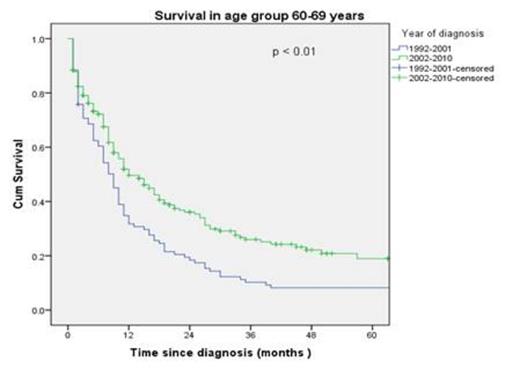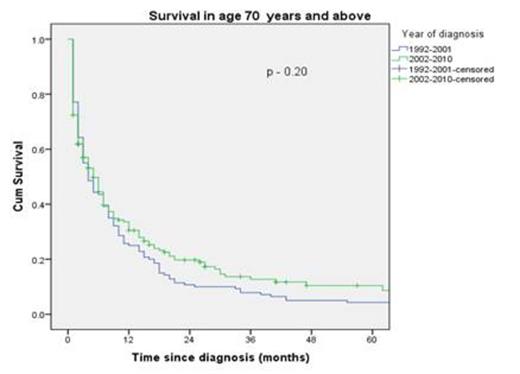Abstract
B-lineage Acute Lymphoblastic Leukemia (B-ALL) is the commonest form of ALL in elderly age. Prognosis in this group is generally considered poor due to higher incidence of t(9,22) and other mutations which increase with age and presence of higher comorbidities. It is unclear if the survival has improved over time in this high risk group with addition of newer agents like tyrosine kinase inhibitors and monoclonal antibodies along with chemotherapy.
Patients were selected from the 13 SEER registry sites (1992 onwards) in the Nov 2012 submission data. Patients included were 60 years and above, with microscopy confirmed B-ALL as the first primary malignancy diagnosed between 1992-2010. We excluded patients diagnosed only at autopsy/death certificate and without survival or demographic data. Patients were evaluated by period of diagnosis (1992-2001 and 2002-2010) and age at diagnosis (60-69 years, 70 years and above). Baseline characteristics were noted (age, sex, race including white, black, Native American, Asian/Pacific Islander). Descriptive statistics were used for comparison of baseline characteristics. One-year and 5-year overall survival (OS) were estimated by Kaplan-Meier method and compared by log rank test. Determinants of OS were analyzed with Cox-regression method. Statistical analyses were done with significance level of p < 0.05.
Among 646 patients who were ≥60 years with B-ALL, 239 patients were in 1992-2001 group and 407 patients were in 2002-2010 group. Mean age was 71.7 years for patients in 1992-2001 group and 70.8 years for patients in 2002-2010 group (p=0.12). Both groups had similarly more males than females, more whites than blacks and other races (Table 1). Patients between 60-69 years had 1-year OS of 50.3 % in 2002-2010 group compared to 32.3 % in the 1992-2001 group (p=0.01). Five-year OS in 2002-2010 group was 20.2% compared to 8.1% in 1992-2001 (p<0.01)(Figure 1). Patients 70 years or older had no significant improvement in 1 year OS or 5 year OS over this period of time (5 year OS 5.5 % in 1992-2001 vs. 12.2 % in 2002-2010, p-NS) (Figure 2). In multivariate analysis, 2002-2010 group was associated with lower mortality (HR 0.77, P=0.004) and age >70 was associated with higher mortality (HR 1.56, P=0.001).
Patients between the ages of 60 and 69 years with B-lineage ALL treated after 2001 had improved 1-year OS and 5-year OS compared to those treated prior to 2001 reflecting efficacy of new therapies in this age group. However, patients above 70 years of age need more effective and safe therapeutic options to improve the survival outcome.
Baseline characteristics
| Variable . | 1992-2001 (n=239) . | 2002-2010 (n=407) . | p value . |
|---|---|---|---|
| Age 60-69y | 99 | 217 | 0.11 |
| >70y | 140 | 190 | |
| Race Whites | 199 | 323 | 0.43 |
| Blacks | 14 | 27 | |
| Others (American Indian, Asian/ pacific islander) | 26 | 57 | |
| Sex Males | 129 | 201 | 0.14 |
| Females | 110 | 206 |
| Variable . | 1992-2001 (n=239) . | 2002-2010 (n=407) . | p value . |
|---|---|---|---|
| Age 60-69y | 99 | 217 | 0.11 |
| >70y | 140 | 190 | |
| Race Whites | 199 | 323 | 0.43 |
| Blacks | 14 | 27 | |
| Others (American Indian, Asian/ pacific islander) | 26 | 57 | |
| Sex Males | 129 | 201 | 0.14 |
| Females | 110 | 206 |
No relevant conflicts of interest to declare.
Author notes
Asterisk with author names denotes non-ASH members.



This feature is available to Subscribers Only
Sign In or Create an Account Close Modal